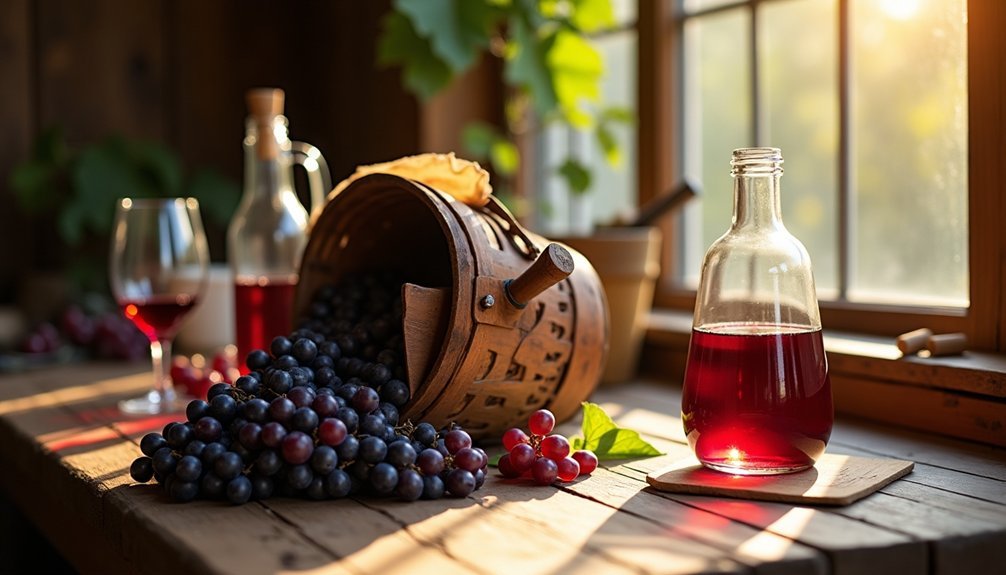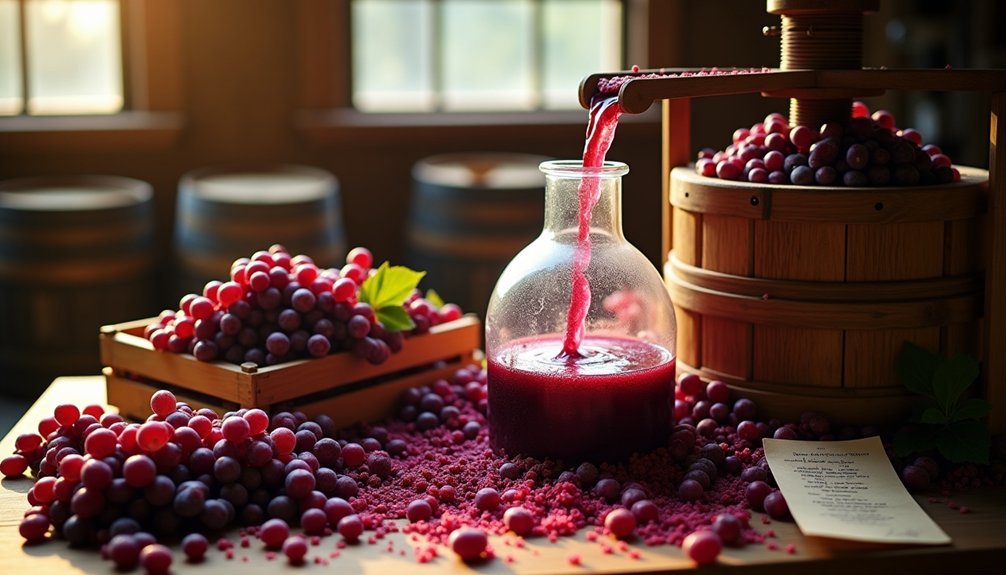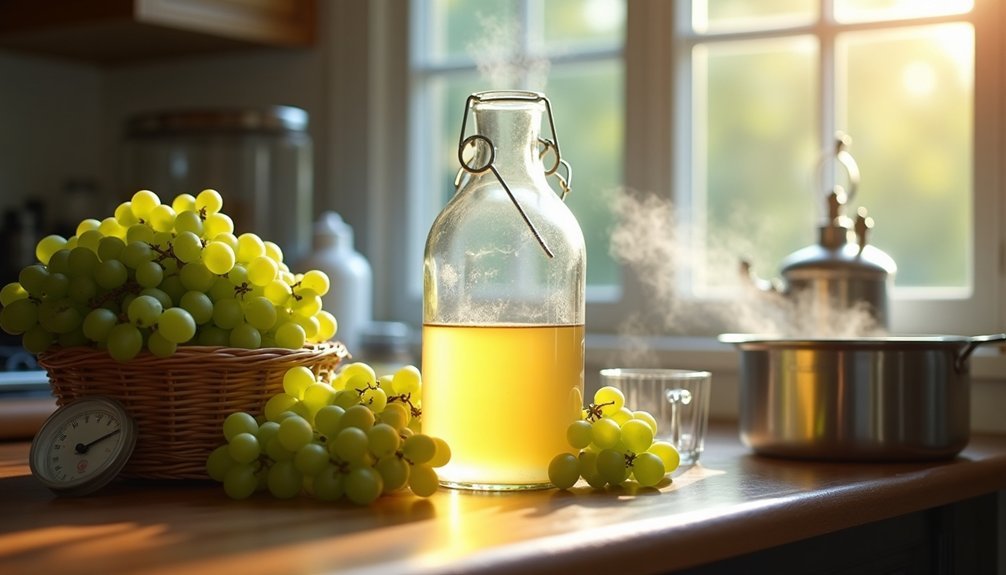I’ve spent years perfecting the art of homemade winemaking, connecting with a tradition that spans millennia. There’s something deeply satisfying about transforming fresh grapes into a complex, flavorful wine using nothing more than basic equipment and patience. My rustic approach strips away the complexity that intimidates most beginners, focusing instead on the fundamental process that’s worked for generations. Whether you’re a curious novice or seeking authenticity beyond store-bought varieties, what follows will guide you through each simple yet essential step.
Why You’ll Love This Drink
Whether you’re a wine enthusiast or a beginner in home brewing, this grape wine recipe will captivate your senses. I’ve crafted this method to be approachable while delivering exceptional results that rival store-bought varieties.
What makes this recipe special is its simplicity—just grapes, yeast, and optional sugar transform into a delicious homemade wine. You’ll appreciate controlling exactly what goes into your drink, avoiding preservatives and additives found in commercial options.
There’s something deeply satisfying about nurturing your own wine from fresh grapes to finished bottle. The process connects you to ancient traditions while creating something uniquely yours. Plus, you’ll impress friends when you casually mention that the excellent wine they’re enjoying is your own creation!
Ingredients
To create this wonderful homemade wine, you’ll need remarkably few components. The star of the show is 12-15 pounds of grapes—I prefer using black or red varieties for their rich flavor profiles and beautiful color.
You’ll also need wine yeast, which is essential for proper fermentation. Don’t substitute with bread yeast, as it won’t create the alcohol content or flavor profile we’re looking for.
While optional, I sometimes add sugar to adjust the sweetness level, especially if my grapes aren’t naturally sweet enough. The amount depends entirely on your taste preferences.
That’s it! Just three simple ingredients transform into a complex, delicious homemade wine. The beauty of this recipe is in its simplicity, letting the natural grape flavors shine through.
Directions
Now that you have all your ingredients ready, let’s plunge into the winemaking process. I’ll walk you through each step to guarantee your homemade wine turns out perfectly.
First, carefully destem your grapes and press them to extract all that flavorful juice. Pour this precious liquid into your fermentation bucket. If your grapes aren’t naturally sweet enough, this is when you’d add sugar to taste.
Next, sprinkle in your wine yeast and let nature work its magic for 7-10 days. During this primary fermentation, you’ll notice bubbling and activity.
After this initial period, transfer your wine to a carboy for secondary fermentation. This should continue for about 4 weeks at room temperature (68-72°F). Once complete, let your wine mature for a few weeks before bottling.
Substitutions and Variations
While traditional grape varieties make excellent wine, you don’t need to limit yourself to just one type. I’ve found that blending different grape varieties can create unique flavor profiles. Try mixing Concord with Muscadine for a sweet-tart balance, or experiment with combining red and white varieties for a rosé-style wine.
If grapes aren’t available, you can substitute other fruits like blackberries, plums, or cherries. Just maintain the same weight ratio. For a sweeter wine, I’ll add up to 2 pounds of sugar to the initial juice mixture.
You can also infuse your wine with herbs or spices. I love adding a cinnamon stick, star anise, or vanilla bean during the secondary fermentation. Just remember to remove them before bottling to prevent overwhelming flavors.
Additional Things to Serve With This Drink
Homemade wine deserves perfect pairings to elevate your tasting experience. I’ve found that my rustic grape wine pairs beautifully with a thoughtfully arranged cheese board featuring aged cheddar, creamy brie, and tangy goat cheese. Add some fresh grapes (a nod to your wine’s origins) and toasted walnuts for texture.
For heartier companions, try serving your homemade wine alongside pasta with mushroom sauce, grilled lamb chops, or a classic beef stew. The wine’s natural acidity cuts through rich foods wonderfully.
Don’t forget a simple water pitcher and some crusty bread on the side. These humble additions cleanse the palate between sips, allowing you to fully appreciate your wine’s complex flavors that you’ve patiently cultivated over those weeks of fermentation.
Final Thoughts
After completing this wine-making journey, I’ve discovered that creating homemade grape wine offers rewards beyond the final product. There’s something deeply satisfying about transforming fresh grapes into a bottle of wine that carries your personal touch.
I’ve found that patience truly is the key ingredient. While the fermentation process might seem lengthy, those weeks of waiting result in complex flavors that simply can’t be rushed. Don’t be discouraged if your first batch isn’t perfect—wine-making is both science and art.
Remember that your homemade creation reflects the quality of grapes you’ve chosen and the care you’ve invested in the process. Whether you’re sharing with friends or enjoying a quiet evening alone, there’s nothing quite like sipping wine you’ve crafted from scratch.



